Text

Make Love not War
Historical Peace Movements and the Ongoing Relevance of War and Peace
Since antiquity, philosophers and state leaders have grappled with the concepts of war and peace. Early on, thinkers like Plato and Aristotle recognized the destruction that wars can bring and advocated for peace as the ideal state for humanity. In the Middle Ages, the Church played a significant role in promoting ideas of peace, including through the 'Peace of God movement', which aimed to minimize wars among Christians.
The modern era saw the emergence of organized peace movements, particularly in the 19th century, when societies such as the American Peace Society and the British Peace Society were founded. These organizations advocated for the peaceful resolution of international disputes and laid the groundwork for later international cooperation to prevent conflicts.
The 1960s: A Turning Point
The 1960s marked a high point of peace movements, driven by the shadow of the Cold War and the fear of nuclear annihilation. In the UK, this led to the founding of the Campaign for Nuclear Disarmament (CND) in 1958, whose peace symbol became a global sign of resistance against war. In the USA, the Vietnam War mobilized wide sections of the population, especially young people and students, who through organizations like Students for a Democratic Society (SDS) and others, initiated massive protests and demonstrations against the war.
The Carnation Revolution: A Peaceful Overturn
A prominent example of a successful and predominantly peaceful revolution is the Portuguese Carnation Revolution of 1974. This revolution not only ended nearly five decades of dictatorship in Portugal but also inspired movements worldwide that saw changes could be achieved through nonviolent means. The soldiers who carried carnations in their gun barrels became a lasting symbol of peaceful change and demonstrated that the military can play a constructive role in promoting democracy and human rights.
Current Situation: War and Peace in the 21st Century
Today, at a time when conflicts are increasing in many parts of the world, the issue of war and peace remains of crucial importance. Regional conflicts, the risk of escalation of violence, and the humanitarian crises caused by wars call on us to learn from history and strengthen active peace efforts. The lessons from movements like the Carnation Revolution and the protests of the 1960s show that societal and international pressure can be crucial in bringing about political changes and securing peace in the long term.
Base image generated with DALL-E, overworked with SD-1.5/SDXL inpainting, manual editing and composing.
#HistoricalPeaceMovements#WarAndPeace#makeLoveNotWar#stopWar#CarnationRevolution#gayart#loveSoldier#peace#gaycomic
15 notes
·
View notes
Text
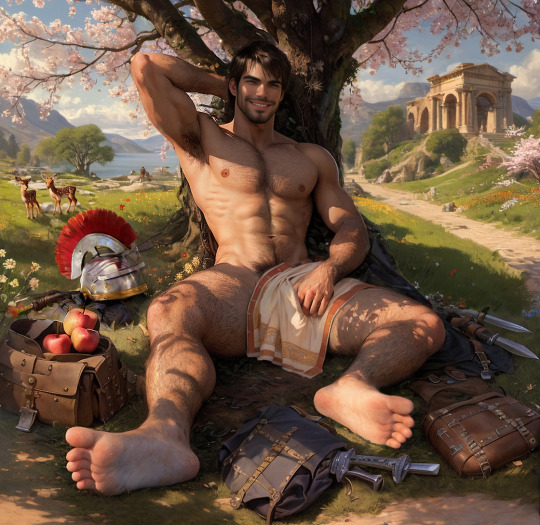
Well Earned Relaxation in Pax Romana
An Era of Peace and Prosperity in the Roman Empire
The Pax Romana, which literally means "Roman Peace," refers to a roughly 200-year period of relative stability and peace within the Roman Empire. This phase officially began with the end of the civil wars following the assassination of Julius Caesar and was solidified by Augustus, the first Emperor of Rome, who reigned from 27 BC to 14 AD.
Stability and Security
During the Pax Romana, the Roman Empire experienced a significant reduction in large-scale military conflicts, which allowed the Romans to focus on internal development and expansion through diplomacy and cultural integration. The empire's borders were secured by the construction of fortresses and the stationing of legions, which strengthened internal security and facilitated trade and travel within the empire.
Architectural and Infrastructural Developments
This period was marked by extensive construction projects, including roads, aqueducts, baths, and public buildings, which not only improved the quality of life but also served as symbols of Roman order and efficiency. Significant structures like the Pantheon, the Trajan's Markets, and the numerous triumphal arches are testimonials of this era.
Economic Upsurge
The political stability contributed to an economic boom. Agriculture, crafts, and trade flourished due to the improved infrastructure and a unified currency that simplified commerce both within and outside the empire. Cities, especially Rome itself, experienced massive growth, supported by migration from the provinces.
Social and Cultural Influence
The Pax Romana also enabled a vibrant cultural and scientific exchange, promoted by the network of roads and cities that rapidly spread cultural diversity and new ideas. Latin and Greek were established as the lingua franca of the empire, and education thrived in the numerous new public libraries and schools.
The Legacy of the Pax Romana
The Pax Romana laid the foundation for modern understanding of state infrastructure and public administration. Although the Roman Empire eventually fell, the ideals of the Pax Romana remain as a golden era of peace and prosperity in historical memory.
This period demonstrates how crucial stability and strategic leadership are for the prosperity of a society. It offers valuable insights into the role of peace and order in promoting economic and cultural development.
Image generated with a depthMap of a 3D render with SD-1.5/SDXL, overworked with inpainting and manual composing.
22 notes
·
View notes
Text

Eternal Springs
Where Nature and Love Converge
Base image generated with SD-1.5, overworked with SD-1.5/SDXL inpainting, manual editing and composing.
10 notes
·
View notes
Text
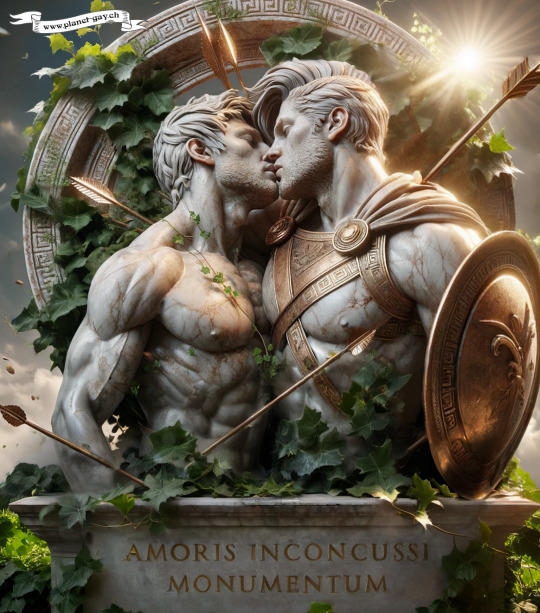
Monument of Unwavering Love
Historical Figures and the Persecution of Their Love
From antiquity to the 20th century, significant individuals who were in homoromantic relationships often faced challenges and criticism. Their stories are testimonials to the courage and resilience in the face of societal hostility.
Hadrian and Antinous: Love Against the Empire
The relationship between Roman Emperor Hadrian and his beloved Antinous was a mix of deep affection and public scandal. After the mysterious death of Antinous, Hadrian deified him, which caused discontent among the Roman elite. This worship was not only an act of mourning but also a defiance of the norms of Roman society.
Oscar Wilde: The Price of Truth
In Victorian England, the famed writer Oscar Wilde paid a high price for his homosexual relationships. His conviction for "indecent acts" led to a harsh prison sentence that ruined his health and destroyed his career. Wilde's case was a clear signal of the intolerance toward homosexuality during this era.
Alan Turing: A War Hero Betrayed by His Own Country
Alan Turing, whose work was crucial to the Allied victory in World War II, was persecuted for his homosexuality. At a time when homosexual acts were illegal in Britain, Turing underwent a medical treatment mandated by the court, which was seen as an alternative to imprisonment, and contributed to his premature death.
Frida Kahlo: An Art Icon in the Gender Norms Crossfire
Although Frida Kahlo's bisexual relationships were not the cause of public animosity, she lived in a society where such relationships were considered taboo. Kahlo's self-portraits and works reflect her personal struggles and her courage to challenge the conventional gender roles of her time.
Bayard Rustin: In the Shadow of the Civil Rights Movement
As an openly gay man and a key advisor to Martin Luther King Jr., Bayard Rustin often had to put his sexuality behind his work for the civil rights movement in the 1960s USA. Despite his significant contributions, he was attacked by opponents both inside and outside the movement because of his homosexuality.
Leonard Matlovich: A Soldier Against Silence
Vietnam War veteran Leonard Matlovich, who appeared on the cover of "Time" magazine, was one of the first to challenge the ban on homosexuality in the U.S. military. His fight against discrimination sparked a national discussion about the role of LGBTQ+ individuals in service.
Base image generated with DALL-E, overworked with SD-1.5/SDXL inpainting, manual editing and composing.
#LGBTQHistory#Pride#UnwaveringLove#CivilRights#HistoricalFigures#LoveWins#LGBTQHeroes#SocialChange#EqualityForAll#gayart#queer#gaylove#gayhistory
12 notes
·
View notes
Text

Summer-Love
Image generated with SD-1.5, overworked with inpainting and composing.
#gaycouple#gayart#relaxinglove#boyfriend#boylovesboy#gaylove#LGBT#springlove#boys#summerlove#muscles#friendship#hairyman#cuddlecare
22 notes
·
View notes
Text

The Minoan Civilization: An Early Example of Advanced Culture on Crete
The Minoan civilization, named after King Minos, a figure from Greek mythology, experienced its peak on the island of Crete from about 2000 to 1450 BCE. This culture is often regarded as one of the first advanced civilizations in Europe and exhibited remarkable liberalism and progressiveness, which were evident in many aspects of their society.
Cultural and Social Achievements
The Minoan society was characterized by its open and progressive attitude, as seen in the splendor of its architectural works, such as the richly decorated palaces, and in its art, exemplified by detailed frescoes and intricate jewelry. The artistic representations, including images of women in airy garments and men ritually leaping over bulls, illustrate a culture that highly valued physicality and aesthetic expression.
Progressive Views on Love and Relationships
A particularly striking feature of the Minoan civilization was its attitude towards homoerotic and homoromantic relationships. Compared to other ancient cultures, where such relationships were often taboo, artistic and ritualistic depictions suggest that in Minoan society, love and erotica in various forms were recognized and possibly celebrated. This openness is a testament to the liberal stance of the Minoans.
Economic Foundations and Trade Relations
The economy of the Minoan civilization was heavily influenced by trade. The Minoans maintained extensive trade contacts with other cultures of the Mediterranean, which not only increased their wealth but also promoted cultural exchange. Unlike many contemporary cultures that expanded through military conquests, the Minoans were primarily known as traders rather than warriors. These trade relationships supported a society that focused more on cultural development and economic exchange than on warfare.
Influence on Subsequent Cultures
The Minoan culture likely had a profound impact on later Greek culture. Elements of their art, architecture, and religious practices can be seen in Greek culture, indicating a strong cultural connection. These legacies show that the Minoans left a significant mark not only in their own time but also in the broader sweep of history.
In summary, the Minoan civilization was an impressive example of a liberal and progressive society that was ahead of its time in many areas. Its cultural achievements, particularly in art and economics, as well as its open social structures and attitudes, make it a fascinating subject of study in the history of human civilizations.
Text supported by Chat GPT-4
Base images generated with DALL-E, overworked with SD-1.5/SDXL inpainting and composing.
#MinoanCivilization#AncientCrete#Archaeology#HistoricalSociety#LiberalCivilizations#ArtHistory#AncientEconomics#CulturalDevelopment#GreekCulture#HistoricalImpact#gayart#queer#manlovesman#LGBT#gaylove#homoromantic
18 notes
·
View notes
Text
Summer is coming, and the boys are out again.
Image generated with a depth map of a 3D render in StableDiffusion 1.5 overworked with inpainting and composing

12 notes
·
View notes
Text
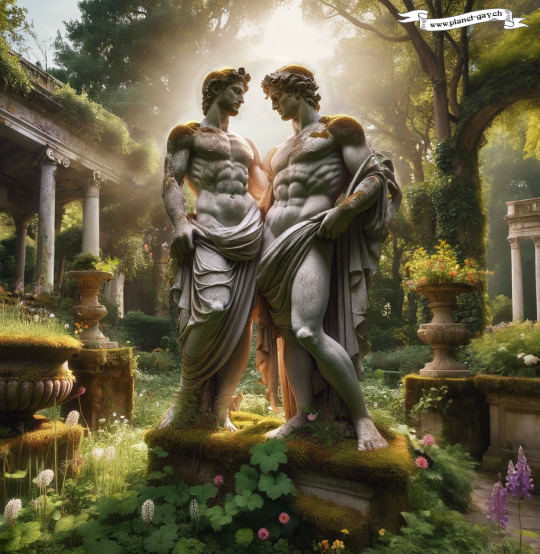
Abandoned Roman Villas (Part II)
As the Roman Empire faced its decline in the 5th century, it left not only political and cultural imprints but also its stately villas, which were gradually reclaimed by nature. These abandoned monuments caught the interest of the Norse and Germanic peoples as they moved through their new territories.
For the Norse peoples, who lived in a world shaped by nature where belief and myth were closely intertwined, the abandoned Roman estates must have appeared mystical and almost surreal. The magnificent buildings, standing amid wildly overgrown gardens and crumbling walls, were like windows to another world—a world left behind by the Romans, whose way of life was fundamentally different from that of the Germanic and Norse peoples.
The ruins were likely seen as places of great power and magic. Norse legends and traditions that deal with decayed structures often speak of "enchanted places" where the spirits of the past are still palpable. The villas might have been regarded by the Norse as magical sites inhabited by the spirits of the Roman nobility who once populated these halls.
Reports from this era are sparse, but it is likely that the Norse interpreted the Roman statues and artworks they found as representations of Roman gods and mythological scenes that were foreign to them. These artifacts may have been treated with reverence or even seen as potential relics or talismans that could offer power or protection.
The rapid reclamation of the villas by nature could also have been seen as symbolic of the victory of the 'wild' natural order over the 'civilized' Roman one. This fits well with the Norse view of nature as a central, life-giving, and sometimes destructive force.
While there are no concrete historical records of the Norse peoples' thoughts on the specific villas, we can speculate that these places were viewed as magical, eerie, and inhabited by spirits. The abandoned Roman villas were not only silent witnesses to past glory but also canvases for the mythologies and cultural expressions of the new 'owners' of these lands.
Overall, the ruins of the Roman villas provided the Norse and Germanic peoples with plenty of reasons for awe and speculation and were likely regarded as significant cultural and spiritual sites where the past and present mysteriously converged. These encounters with the remnants of Roman civilization may have contributed to a rich layer of myths and legends that shaped the Norse culture and its relationship with the past.
Text supported by Chat GPT-4
Base images generated with DALL-E, overworked with SD-1.5/SDXL inpainting and composing.
#AbandonedVillas#RomanEmpire#NorseMythology#CulturalHeritage#HistoricRuins#NatureReclaims#MythAndLegend#SpiritualSites#AncientCivilizations#CulturalConvergence
4 notes
·
View notes
Text

The Decline of the Roman Empire and the Forgetting of Roman Villas
Throughout the 5th century, the once mighty Roman Empire experienced a series of political, economic, and military crises that ultimately led to its downfall. It is this era of transition and decay during which the magnificent Roman villas were abandoned and reclaimed by the relentless force of nature.
The fall of the Western Roman Empire was not an abrupt event but the result of a lengthy process accelerated by various factors. Among these were economic stagnation, characterized by a declining trade network and a shrinking tax base. Additionally, political unrest, civil wars, and the erosion of state structures contributed to the weakening of central power.
Another decisive factor was the migration period, a time of intense migration of various Germanic and other tribes, partly due to population pressure and climate change, and partly attracted by Rome's wealth. The Goths, Vandals, Franks, Lombards, and many other groups crossed the borders and settled on Roman territory, often leading to conflicts and looting.
The Roman villas, once symbols of wealth and cultural life, were frequently abandoned during this time. Many of the aristocratic owners fled to the safer cities or were driven away by the invading tribes. Without their owners and the slaves or tenants who worked and maintained the land, the buildings quickly fell into disrepair.
Nature swiftly took over the deserted places. The carefully maintained gardens of the villas became overgrown, as there was no one left to trim and shape them. Native plants and trees overran the intricate mosaics and impressive statues, while climbing plants entwined the once proud columns, undermining the structure of the buildings.
Archaeological finds from this period give us a glimpse into the slow process of decay. Mosaics under the root work, statues half buried in the ground, and hoards of coins buried in haste tell the story of a bygone era of splendor and subsequent forgetting.
The decay of the Western Roman Empire and the abandonment of the Roman villas mark the end of antiquity and the beginning of the Early Middle Ages in Europe. The overgrown ruins of these villas are silent witnesses to the once Roman heritage and the unstoppable force of nature, which ultimately always reclaims its space. They remind us of the transience of human works and the incessant course of history.
The story of the decline of the Roman Empire and the associated return of nature over the abandoned villas has remarkable relevance today. It reminds us of the fragility of human civilizations and how quickly nature can take over human-made structures once conservation efforts wane. This theme is particularly resonant at a time when global challenges such as climate change, environmental destruction, and socio-economic upheavals are at the forefront.
The ruins of the Roman villas can be seen as a metaphor for the need to protect our environment and live sustainably to prevent our own "villas" – our cities and communities – from similarly decaying one day. They also caution us that, despite the apparent permanence of our modern world, we too are vulnerable to the forces of change and time.
History offers us lessons on the importance of adaptability, resilience, and the necessity to preserve the environment we live in. It also shows how cultural and historical sites can be lost over time if not actively protected and maintained. In a broader context, it encourages reflection on how we preserve our history while simultaneously shaping a sustainable future.
Text supported by Chat GPT-4
Base images generated with DALL-E, overworked with SD-1.5/SDXL inpainting and composing.
#RomanEmpire#ForgottenVillas#AncientRuins#NatureReclaims#HistoryLessons#Sustainability#CulturalHeritage#lostgarden#romantic#statues
4 notes
·
View notes
Text
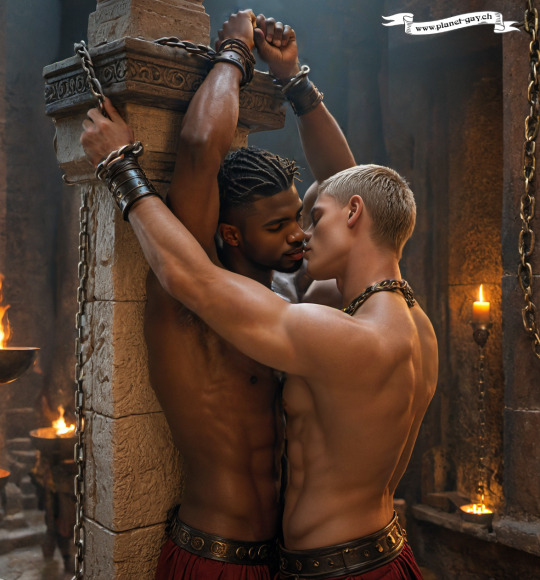
United by Fate
Sometimes it's the chains of fate that unexpectedly bring us closer together. In encountering the other, in confronting what appears foreign, lies the opportunity to overcome prejudices and to realize that it is precisely our differences that enrich the mosaic of human relationships. In conflict, we often discover an unexpected closeness, a depth in relationships that is forged in the fire of conflict and welded together by fate.
Transformation work from an an older pictures depth map made with Poser-3D and G2M Figures over ControllNetV1.1.410 and AI inpainting and composing with SDXL.
#UnitedByDestiny#HumanConnections#OvercomingPrejudice#UnityInDiversity#BondsOfFate#OppositesAttract#gayart#gaylove#lgbt#bdsm#inchain#fate
28 notes
·
View notes
Text
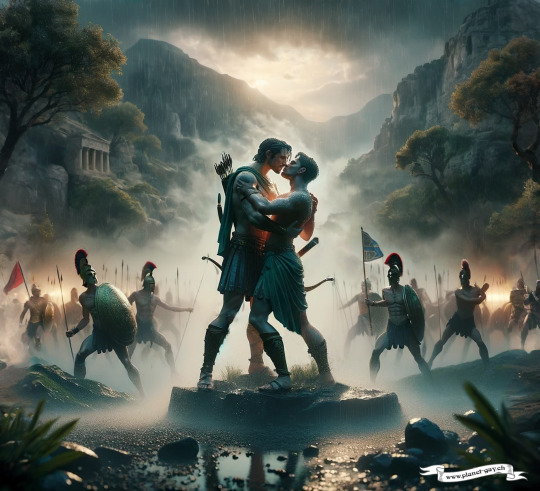
When Love Defies Battle Lines the battle take a surprising turn.
Image generated with DALL-E, overworked StableDiffusion SDXL-1.0 (DreamDiffusionXLSD) with inpainting and composing.
#LoveOverWar#BattlefieldRomance#WarriorLove#Peace#ErosAndAres#LoveDefiesConflict#MythicalMoments#LoveInTheTimeOfBattle#WarriorKiss#gayart#queer#lgbt#manlovesman#mankissman
7 notes
·
View notes
Text

The Egg Hunting goes on...
Image generated with StableDiffusion 1.5 overworked with inpainting and composing.
#LoveInSpring#EasterMonday#EasterJoy#SpringCelebration#EasterEggs#BunnyLove#gayart#queer#hotboy#hotman#egghunting#muscleman
21 notes
·
View notes
Text

Spring Awakening
Out of the grey winter slumber and finally back into the warm nature where the flowers awaken and the hormones dance. Ready for new adventures in love, sports, and summer fun.
Image generated with DALL-E, overworked StableDiffusion SDXL-1.0 (DreamDiffusionXLSD) with inpainting and composing.
#SpringAwakening#NatureReborn#LoveInSpring#EasterSunday#EasterJoy#SpringCelebration#EasterEggs#BunnyLove#ChocolateEggs#gayart#queer
4 notes
·
View notes
Text

Good Friday and Easter: A Cycle of Death and Rebirth
In the heart of spring, Good Friday and Easter stand as a duo, unified by their contrasts. The silence and sorrow of Good Friday lead us to the joyous celebration of Easter Sunday, a time that celebrates life and hope. These holidays symbolically represent the eternal return, the renewal of life, and the triumph of light over darkness.
From Pagan Spring Rituals to the Christian Festival of Hope:
Easter, the focal point of the church year, is closely tied to the resurrection of Christ. Yet, its roots reach deep into history, to times when spring was honored through pagan festivals that celebrated the cycle of death and rebirth in nature. This piece delves into the history and significance of Easter, highlighting how it has evolved over time.
Celebrating Spring Since the Dawn of Humanity:
Since prehistoric times, people have marked the arrival of spring with festivities that reflected the cyclical nature of life and themes of death and rebirth. These early celebrations were brimming with vitality, signaling the end of winter and the reawakening of nature.
Transformation Through Christianity: Between Good Friday and Easter
As Christianity spread, many of these pre-Christian customs were adapted. The focus shifted to the story of Jesus' crucifixion and resurrection, turning Good Friday and Easter into symbols of death and new life, two sides of the same coin, emphasizing the profound meaning of loss and rebirth.
The Deeper Symbolism:
Good Friday, a day of pause and reflection, paves the way for Easter Sunday, a festival of joy and victory. These contrasts illustrate the eternal cycle of life: darkness gives way to light, sorrow to joy, and from death springs new life. These themes are found worldwide in various cultures and religions, reflecting the human longing for renewal and liberation.
The Relevance of Good Friday:
In many Christian traditions, Good Friday is a deeply spiritual day, marked by prayer and contemplation. Despite its contrast to the festive Easter, it is an essential part of the Easter tradition, symbolizing the emotional and spiritual journey from darkness to light, from death to new life.
The Cosmic Connection:
Interestingly, the period of Good Friday and Easter often coincides with the transition from the Pisces to Aries zodiac signs, forming an intriguing contrast: Pisces represent conclusion and letting go, Aries beginnings, energy, and determination. This astrological phase mirrors the themes of Easter, providing an additional layer of interpretation.
Text supported by Chat GPT-4
Images generated with SD-1.5, overworked with inpainting and composing.
#GoodFriday#Easter#Rebirth#Spring#Christianity#PaganTraditions#Renewal#Hope#Spirituality#CulturalTraditions#AstrologicalSigns#gayart#consolation#comfort
11 notes
·
View notes
Text

Make Love not War
Images generated with DALL-E, overworked StableDiffusion SDXL-1.0 (DreamDiffusionXLSD) with inpainting and composing
42 notes
·
View notes
Text
Deep Love and Connection

In ancient Greece, love was not bound by gender but by the beauty of the connection between two souls. This culture did not know our modern terms of homosexuality or heterosexuality. Rather, love was experienced as a multifaceted spectrum that could include all people.
Especially in the world of warriors, this freedom of emotional bonding was pronounced. The famous Sacred Band of Thebes consisted of pairs of men of the same age, whose mutual love was considered a source of their strength. Their bonds were not only strategic in nature but also deeply emotional. Such relationships were publicly acknowledged and respected, as they were seen as an expression of the highest virtue and harmony.
In the education of young men, pederasty was a socially recognized form of relationship between an adult man and a male youth in ancient Greece. These relationships often had an educational component and were an important part of the social structure. Peer-aged pairs were also common. It was a world where men could freely express their affection and admiration for one another without the strict labels that later emerged.
The ancient stories of Achilles and Patroclus or of Alexander the Great and Hephaistion offer examples of profound bonds between peer-aged warriors. The martial culture of ancient Greece, where strength and virtue were highly valued, provided fertile ground for the emergence of such deep emotional connections. For a warrior, the companion at his side was not just a fellow combatant in battle but also a partner in life, with whom all joys and sorrows were shared.
In our modern world, where we still struggle for acceptance, these ancient traditions remind us that love in human history has always been complex and boundless. It awakens in us the memory of a time when love was free from prejudice and definitions and celebrated for what it truly is: a deep connection between people.
Text supported by Chat GPT-4
Images generated with SD-1.5, overworked with inpainting and composing.
#hashtags#DeepLove#Connection#AncientGreece#SacredBandOfThebes#Pederasty#Achilles#Patroclus#AlexanderTheGreat#Hephaistion#LoveBeyondLabels#gayart#gaylove#manlovesman#muscles#washbaoardabs
25 notes
·
View notes
